FreeNAS Compatible Hardware List
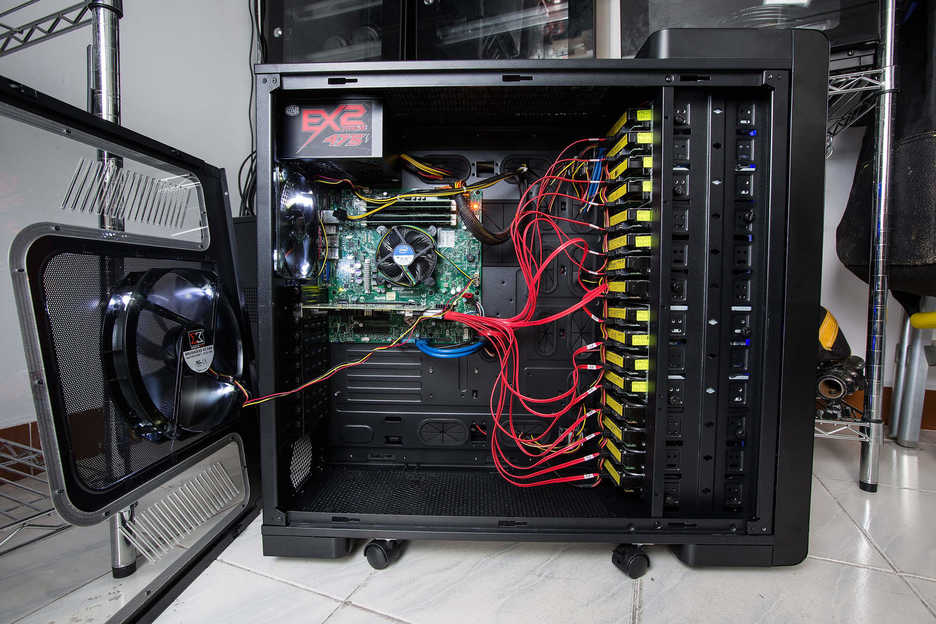
These are the hardware combinations I use with FreeNAS. I am currently running FreeNAS 9.10.x and have used most of the below hardware with earlier versions of FreeNAS 9 and 8.
Please note that only the first three systems listed use ECC RAM; I would have built the other systems using ECC components had I been aware of the risks inherent in running ZFS on non-ECC systems. ECC compatibility aside, IPMI is also a feature generally only available on server-grade motherboards which also support ECC; if you are building your own FreeNAS system (and why else would you have found this page?), do yourself a favor and look for a MB and processor with ECC support and IPMI.
Systems
- 1 Intel Xeon E3-1230V3 Haswell 3.3GHz 8MB L3 Cache LGA 1150 80W quad-core server processor
1 Supermicro uATX server motherboard MBD-X10SLM-F-O
1 LSI SAS 9201-16i HBA
4 Samsung M391B1G73BH0-CK0 DDR3-1600 8GB ECC RAM (specified by Supermicro for use with the X10SLM-F-O)
16 3TB ‘green’ drives (mostly WD with a few Seagate)10 4TB “green” and “blue” WD drives 6 Toshiba 8TB MG05ACA800E drives1 Antec TP-450C 450W 80-Plus Gold PSU. The TP-450C is supposedly made by Seasonic for Antec and relatively high-quality. It replaced the cheap Cooler Master PSU in the picture.1 Corsair RM750x PSU. The Antec TP-450C was still running fine when I replaced it with the Corsair. 1 Xigmatek Elysium chassis. This case is designed for people building home gaming computers but also happens to be reasonably well suited for use as a file server; it is well-ventilated, has relatively quiet fans, and - most import - can be configured to hold 16 hard drives in the 12 5.25” bays (using the two included 4 in 3 HDD cages plus two more).
The 16 hard drives are arranged in two vdevs comprising a single pool; one ZFS Raid Z2 vdev has ten drives while the other has six. This system started out with 10 drives; I added the six when I ran out of room. I ran out of space so have replaced the six drives in the smaller vdev with 4 TB drives (the server now has 10 3TB drives and 6 4TB drives).
This motherboard can accept two 8x HBAs if needed (I’m only using one slot at present).
This NAS is shown in the picture at top with an older power supply (which is noisy and inefficient…) and also here.
- 1 Intel Xeon E3-1230V3 Haswell 3.3GHz 8MB L3 Cache LGA 1150 80W quad-core server processor
1 Supermicro uATX server motherboard MBD-X10SLM-F-O
2 LSI SAS 9211-8i HBA (flashed to the IT firmware).1 LSI SAS 9201-16i HBA 4 Samsung M391B1G73BH0-CK0 DDR3-1600 8GB ECC RAM (specified by Supermicro for use with the X10SLM-F-O) 18 4TB WD WD40EFRX Red drives1 Antec TP-550C 550W 80-Plus Gold PSU.1 Corsair RM750x PSU. The above Antec PSU died. 1 Xigmatek Elysium chassis. We removed nearly all the accessories that are delivered with this case; most of the cabling went out, and we used four hard drive cages that squeeze five 3.5” disks into three 5.25” bays (a total of 20 hard drives could fit in the mounts). The standard Xigmatek HDD cages hold four disks each. Note that the wheels that come with the case aren’t strong enough to survive supporting this many drives; they no longer roll.
The 18 hard drives are arranged in three separate vdevs comprising a single pool; each ZFS Raid Z2 vdev has six disk.
This motherboard’s PCI-e slots can accept two 8x HBAs; the slots are spaced rather close but the 9211-8i chips haven’t suffered heat stroke yet. One of the 9211-8i HBAs went on the fritz; we replaced both 9211s with a single 9201-16i from the US. The faulty 9211 was a relatively inexpensive unit from Taobao, the mainland Chinese version of ebay, a venue know for occasionally listing a few counterfeit items.
This is a friend’s primary file server. Total storage space is just under 43TB. Picture below.
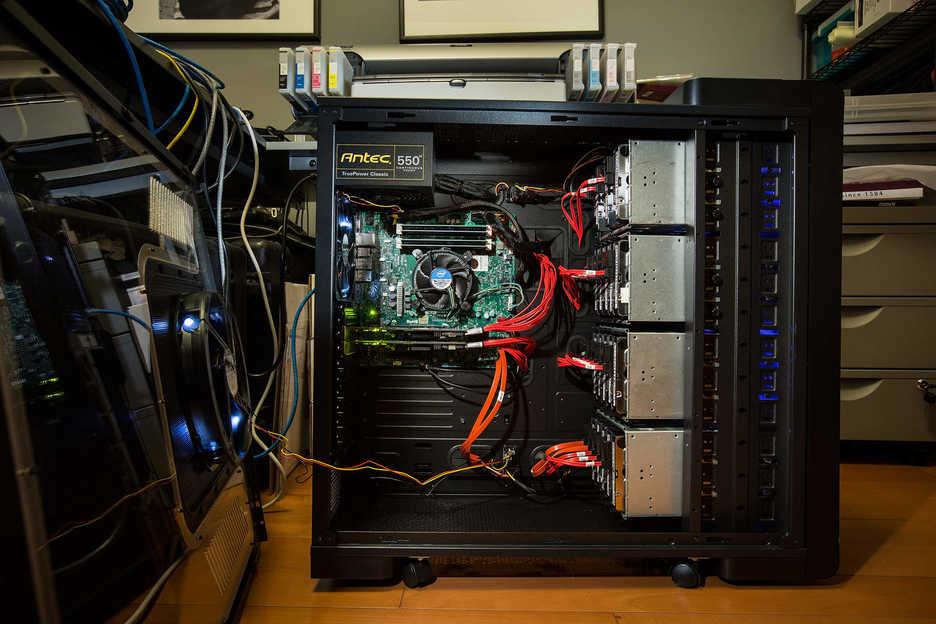
- 1 Intel Xeon E3-1230V3 Haswell 3.3GHz 8MB L3 Cache LGA 1150 80W quad-core server processor 1 Supermicro uATX server motherboard MBD-X10SLM-F-O 2 8GB sticks of ECC RAM - Crucial 16GB Kit (8GBx2) DDR3L 1600MT/s (PC3-12800) DR x8 ECC UDIMM 240-Pin Server Memory CT2KIT102472BD160B - It works but isn’t on Supermicro’s list of tested RAM (which is extremely short). 6 4TB WD WD40EZRX drives 1 Antec TP-450C 450W 80-Plus Gold PSU.
The 6 hard drives are arranged in a single RaidZ2 vdev.
This is a friend’s primary file server. Picture below.
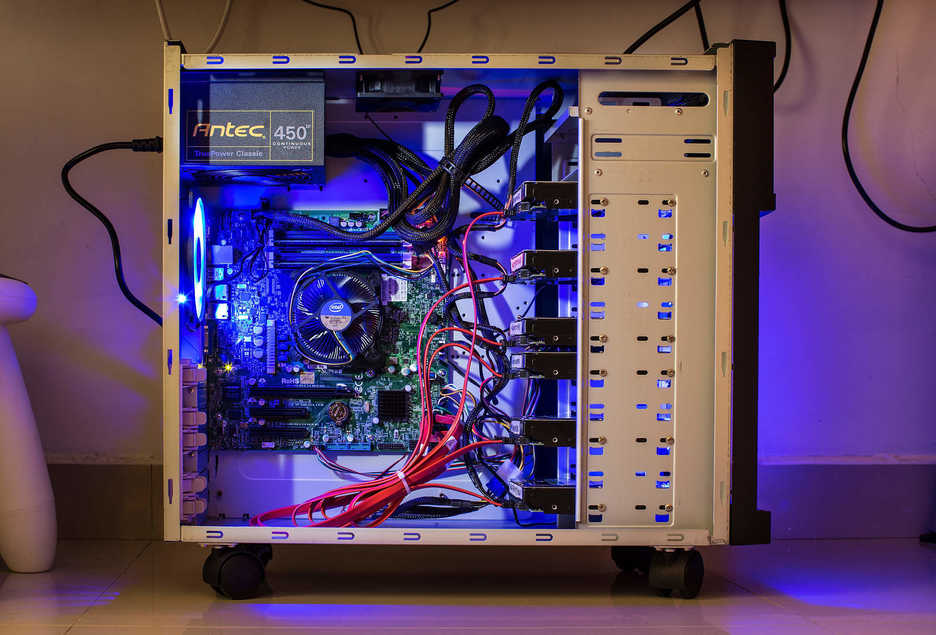
- 1 AMD A4 5300 APU
1 ASRock FM2A85X Extreme 6 motherboard
1 Dell SAS 6/iR- replaced by a 9211 below 2 LSI SAS 9211-8i HBA (flashed to the IT firmware).6 2TB ‘green’ drives (a mix of Seagate and WD)6 3TB ‘green’ drives (a mix of Seagate and WD)18 4TB WD40EZRX and WD40EZRZ drives 2 CORSAIR Vengeance 8GB DDR3 1600 SDRAM1 Cooler Master Extreme 2 475 PSUThis PSU began suffering power issues after a few years of use. I replaced it with the Antec TP-550c below. 1 Antec TP-550C 550W 80-Plus Gold PSU. I aimed for a lower-wattage Seasonic PSU but found Seasonic distribution to Hong Kong and Macau severely lacking. The TP-550C is supposedly made by Seasonic for Antec and relatively high-quality. 1 联志 4165 “4U” server chasis. This is a $50 box from Taobao (which is sort of the Chinese equivelent of eBay). The dimensions of the case aren’t the same as international 4U standards but it does hold what I need it to hold. It has great airflow and the fans aren’t as loud as I feared they might be.
The first two PCI-e slots on this motherboard retain x8 speed with two devices installed (as is required two run two 9211-8i). It was the least expensive motherboard available at the time I bought it that would work with two 9211-8i.
The 16 hard drives are arranged in two vdevs comprising a single pool; one ZFS Raid Z2 vdev has ten 2TB drives while the other has six 4TB disks. This system started out with a single 10-drive RaidZ2 vdev; when that became too small, I expanded it with 6 more 2TB disks in a second vdev. Later, I swapped out those 6 drives (one by one) and replaced them with 4TB drives to grow the pool (thanks to the ZFS autoexpand property).
The 18 hard drives are arranged in three ZFS Raid Z2 vdevs comprising a single pool. A while after this became a backup system, I decided to switch to only using 6-disk vdevs using leftover 2TB and 3TB disks plus 6 fresh 4TB drives.
This is a backup system (thus only 16GB ram). I didn’t know about ECC ram and server motherboards at the time I built it.
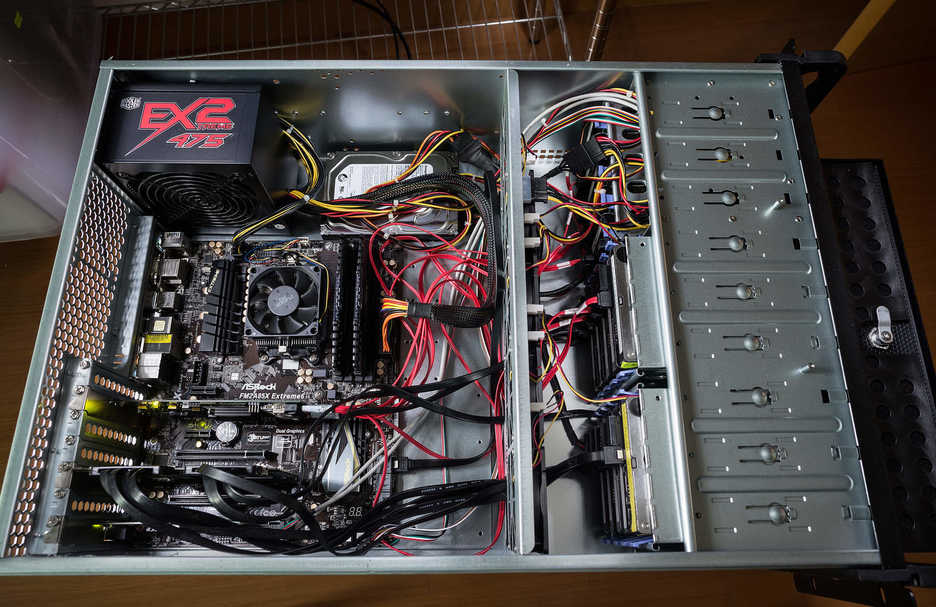
- 1 AMD A10 APU
1 ASRock FM2A85X Extreme 6 motherboard
2 LSI SAS 9211-8i HBA (flashed to the IT firmware).
16 3TB ‘green’ drives (a mix of Seagate and WD)16 4TB drives (a mix of Seagate, WD and Toshiba) 4 CORSAIR Vengeance 8GB DDR3 1600 SDRAM 1 Cooler Master GX-450W PSU
The 16 hard drives are arranged in two vdevs comprising a single pool; one ZFS Raid Z2 vdev has ten drives while the other has six.
The motherboard works well enough with the exception of the ethernet adapter, which can have issues with large sustained transfers (I don’t know if the culprit is the Atheros hardware itself, the FreeBSD drivers or what).
This is a friend’s secondary file server (we recently built a larger primary system using ECC server components). Picture below. I do not recommend cases with this design for holding hard drives: Both sides of the case must be removed to replace drives; cable routing is fraught; the hard drives need to be secured with screws in finicky little caddies…
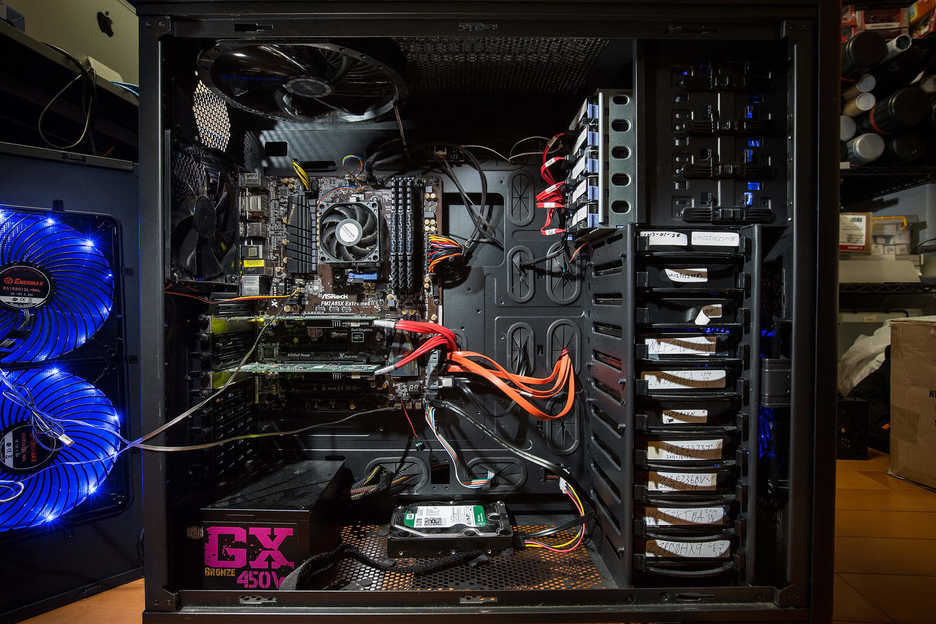
- 1 AMD A6-3670 APU
1 Asus F1 A75-V pro
3 Seagate 2TB hard drives in ZFS Raid Z16 Seagate 2TB hard drives in ZFS Raid Z2
This is a system I helped a friend set up (and which has quickly has become too small, as I predicted). It is running FreeNAS 8.2 at present I believe.>
Motherboards
I don’t use all these motherboards at present but have in the past.
- Supermicro MBD-X10SLM-F-O
This is the best MB I have used; it takes ECC ram, has IPMI, and two of the PCI-e slots are fast enough to support most HBAs (one at x16, second at x8).
Works perfectly. Second PCI-e slot drops to x4 speed when both are in use (will support only one PCI-e HBA).
Works fine, with the exception of the ethernet adapter, which can cause problems with large transfers. 2 PCI-e slots retain x8 speed when both are in use, which is something that is extremely desireable with FreeNAS and difficult to find in comsumer boards.
A very odd choice for a NAS; I only used it temporarily when migrating a system. Can be used with two PCI-e HBAs thanks to the first two slots running at x8 when both are populated.
Works fine. The second PCI-e slot runs at x4 when both slots are populated (will not work with more than one PCI-e HBA).
This will run FreeNAS 8 but is rather slow with ZFS thanks to the RAM limit (4GB). It also can’t run drives larger than 2TB off the internal SATA 3Gb/s ports.
This board works fine with FreeNAS 8 and has a fair number of SATA 6Gb/s ports built-in. Expansion is essentially limited to one PCI-e board thanks to speed limits on the secondary PCI-e slots.
Processors
- Intel Xeon E3-1230V3 Haswell 3.3GHz 8MB L3 Cache LGA 1150 80W quad-core server processor
The rest of the CPUs I’ve used don’t support ECC RAM (and are therefore less than ideal):
- AMD A10-5800K APU
- AMD A8-3870 APU
- AMD A6-3670 APU
- AMD A4 5300 APU
- Intel i7-3770
HBAs
- LSI SAS 9211-8i HBA
It is a pain flashing this card to the IT firmware but once accomplished, it is fantastic. It is possibly the least expensive way to get 8 SATA 6Gb/s connections. The cards I’ve bought cost around US$100 new (in China).
Here are my notes on flashing the LSI 9211 8i to IT mode.
The IBM Serveraid m1015 is apparently functionally identical to the LSI 9211-8i.
The 9201-16i works perfectly out of the box (without flashing) and is less expensive than two new LSI SAS 9211-8i from reputable dealers. It’s also the least expensive way I know of to get 16 ports out of a single PCI-e slot (if your MB only has one slot available that is 8x or faster).
- Dell SAS 6/iR
This board is outdated at 3Gb/s but works okay with 2TB drives; it does not support larger disks.
The SAS ports are an older type that requires an SAS to SATA breakout cable that is now relatively obscure.
Hard Drives
The approach I take with my own systems is to select drives with the lowest cost per gigabyte and longest warranty; at the moment, that means WD40EZRX (the 3TB disks may still be more economical in some places). I use WDIDLE3 on WD drives to adjust the head loading/unloading timer to 300 seconds.
- Seagate 2TB ST2000DM001
- Seagate 2TB ST2000DL003
- Seagate 3TB ST3000DM001
- WD 2TB WDC WD20EARX
- WD 3TB WDC WD30EZRX
- WD 4TB WDC WD40EZRX
- WD 4TB WDC WD40EZRZ
- WD 4TB WDC WD40EFRX
- Toshiba 8TB MG05ACA800E